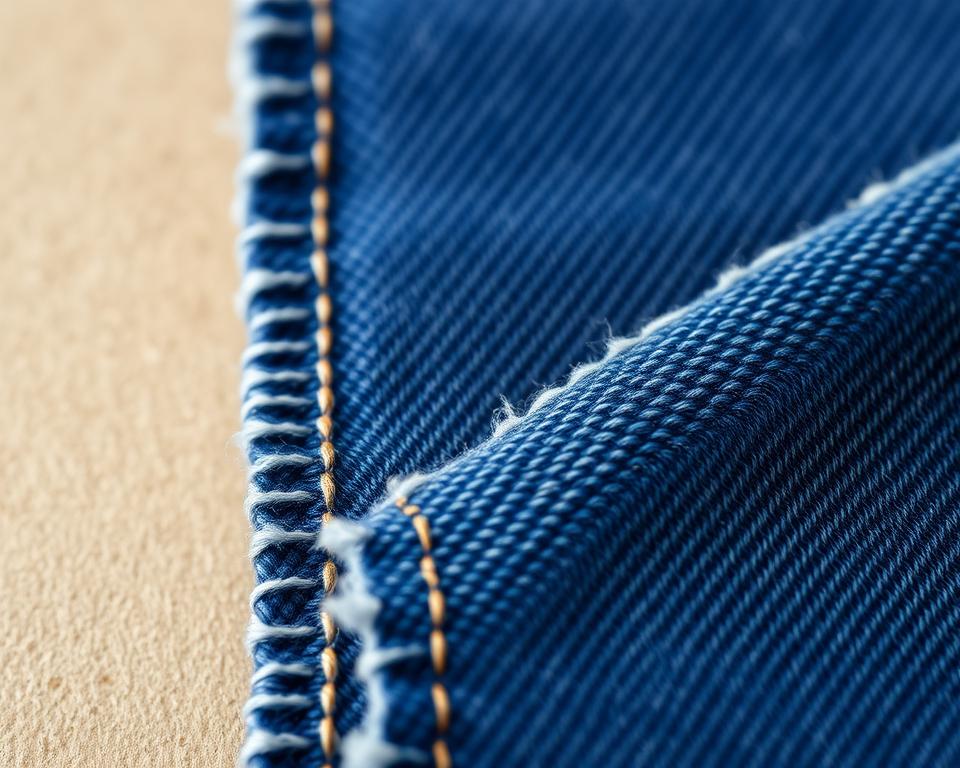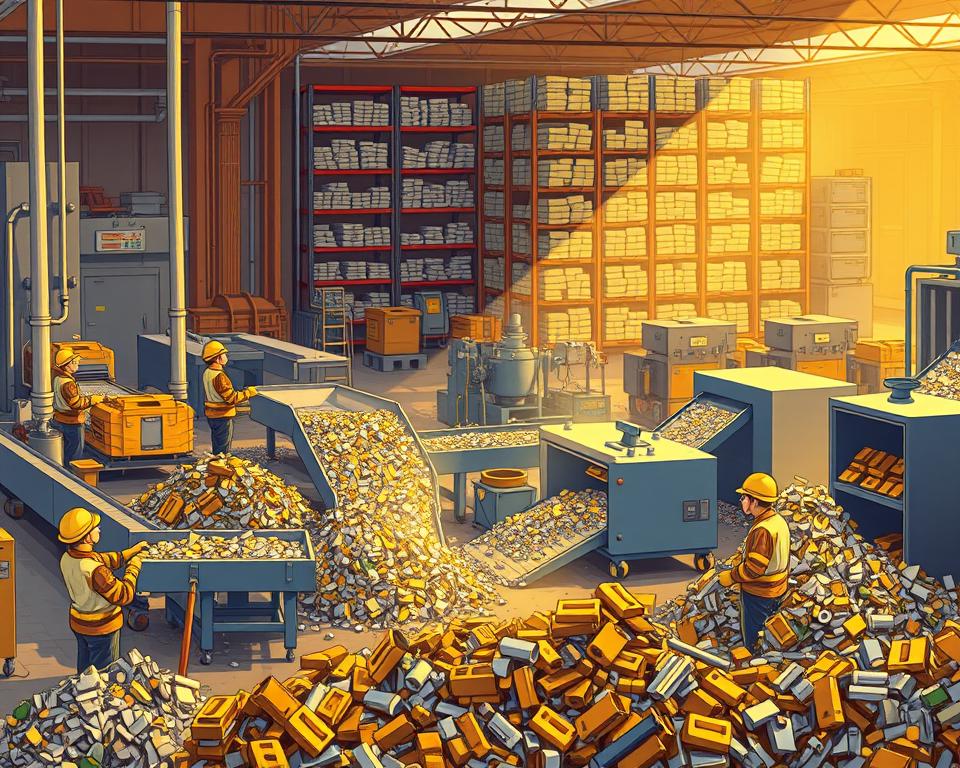Your Ultimate Selvedge Denim Material Handbook
One solitary set of antique Levi’s 501s hailing from the 1940s fetched $87,400 at an auction. Why were these trousers valued higher than a high-end automobile? It all comes down to their selvedge denim fabrication.
This high-end denim stands for more than simple material. It transports us back to when James Dean sported his 501s in Rebel Without a Cause, and Marlon Brando set the standard for cool in The Wild One. Those pop culture legends weren’t merely clad in denim. They wore Gold selvedge denim fabric manufacturers crafted on vintage shuttle looms.
Craft denim derives its title from the self-finished perimeters that avert fraying. “Selvedge” merges “self” with “edge” to denote this distinct weaving technique. Unlike mass-produced jeans, each yard of selvedge denim material takes time and skill to create.
Its feel conveys a history through faint irregularities and innate variations. Every pair acquires character as its indigo wears down. This individual progression renders heritage denim exceptional to collectors and style aficionados alike.
Numerous people assume high-end denim endures beyond ordinary jeans. The fact is somewhat more complex. Selvedge construction creates beautiful fabric with clean edges and rich texture. Yet durability hinges on cotton grade and weight, rather than solely on weaving method. What sets artisanal denim apart is its ability to age gracefully and develop unique fade patterns over time.
Understanding Selvedge Denim Material
Selvedge denim cloth stands apart from standard denim because of its special build and polished borders. It draws its name from the “self-edge,” a dense woven strip that stops fraying. This premium material embodies a dedication to slow fashion and traditional craftsmanship, setting it apart from mass-produced denim.

What Self-Edge Construction Signifies
The word “selvedge” fuses “self” with “edge,” indicating material with a tidy, sealed edge. This narrow selvage runs along both sides, removing the requirement for added finishing. Traditional mills produce it in widths of about 30-32 inches, unlike modern denim’s 60-inch width.
Shuttle Looms and Their Unique Fabric Borders
Denim from shuttle looms derives its persona from antique weaving machines running at reduced speeds. They shuttle one weft yarn across the warp threads in one continuous action. This method results in:
- Natural texture variations called slubs
- A softer hand-feel than modern denim
- Securely finished edges that resist fraying
- Authentic irregularities cherished by denim enthusiasts
Selvedge vs. Standard Denim
Regular denim comes from projectile looms firing weft yarns over broader widths. This method leaves loose threads at the edges, needing overlocked seams to prevent fraying. Selvedge denim fabric, by contrast, demands more time to make. It offers superior durability and a unique aesthetic, justifying its higher cost.
Heritage and Historical Roots of Shuttle-Loomed Denim
Heritage denim’s story began in 19th-century American textile mills. Shuttle looms were key, weaving fabric with tightly woven edges to prevent fraying. That approach yielded indigo-dyed denim slowly and painstakingly, guaranteeing each yard was made with precision. The fabric’s limited width turned into a signature of craft denim making.
From 1800s American Mills to Modern Revival
For more than 100 years, U.S. mills depended on shuttle looms. Brands like Cone Mills and White Oak supplied premium denim to workwear companies. By the 1970s, faster projectile looms took over, replacing most shuttle equipment. That change stemmed from the push for more affordable, mass-made jeans. Many historic mills closed or modernized, leaving vintage looms to gather dust.
The Rise of Japanese Selvedge Excellence
In the 1980s, Japanese producers brought American shuttle looms back into use. The Osaka Five brands led this revival:
- Studio D’Artisan
- Evisu
- Fullcount
- Warehouse
- Denime
These companies merged American vintage style with Japanese precision. They studied old Levi’s patterns, recreating classic indigo-dyed denim textures. By 2000, Japanese makers had overtaken the global artisan denim market.
The Importance of Traditional Weaving Today
Shuttle looms yield distinct cloth traits that contemporary machines cannot replicate. Their reduced-speed weaving enables uneven textures and richer indigo absorption. Hardcore denim fans treasure these quirks as proof of real craftsmanship.
| Shuttle Loom Features | Modern Loom Features |
|---|---|
| 29-31 inch fabric width | 60+ inch fabric width |
| 3-4 yards per hour | 15-20 yards per hour |
| Natural irregularities | Uniform texture |
| Self-finished edges | Cut edges requiring overlocking |
Crafting Premium Denim with Vintage Looms
Premium denim production kicks off with the steady rhythm of antique shuttle looms. These contraptions stand apart from modern machines. They weave yarn across the fabric width in a single thread, locking the edges without finishing. This method ensures selvedge denim has a clean, non-fraying edge.
Vintage looms weave at a slower pace, producing just 5-6 meters of selvedge denim material daily. This sharply contrasts with current machines that manage 200 meters. The slower speed benefits the yarn in several ways:
- Lower tension in threads produces a plusher hand
- Natural irregularities remain intact for unique texture
- Uneven surfaces lead to distinctive fading patterns
- Slim widths (around 29–32 inches) cut down waste
Operating these antique machines requires skilled craftsmen. Weavers tweak tension, keep rhythm, and handle fixes. Every loom boasts its own personality. Some date back to the 1920s, needing specific knowledge passed down through generations. This hands-on approach makes shuttle-loomed denim a true artisan product.
The slim width of dry denim on antique looms offers a real advantage. Pant makers utilize the selvedge edge as the outrigger seam, avoiding waste. This flaunts the cloth’s true craftsmanship. Each bolt tells its own tale, boasting faint differences factory lines can’t duplicate.
Understanding Raw Denim vs Selvedge Differences
Many denim enthusiasts confuse raw denim with selvedge denim fabric. This mix-up appears during premium jean hunts. The truth is, these terms describe different aspects of denim production. Knowing the difference helps you make better choices and appreciate each type’s uniqueness.
Why Not All Selvedge Is Raw
Selvedge denotes the shuttle-loom weaving style that yields self-finished edges. Raw denim stands for unwashed textile direct from production. A selvadge raw denim fabric wholesaler might offer both washed and unwashed options. Companies like Naked & Famous craft selvedge jeans, sometimes pre-washed or stretch-infused.
The weaving technique remains the same. However, finishing transforms both the cloth’s texture and appearance.
Washed vs Unwashed Denim Options
All denim starts as dry denim prior to wash. Mills produce both standard and selvedge versions unwashed. The principal distinctions are:
- Raw denim develops unique fading patterns based on wear
- Rinse-treated denim provides quick comfort and sizing stability
- Sanforized raw stays closer to original measurements after first wash
- Unsanforized denim shrinks notably upon soaking
Breaking Down Common Misconceptions
Not every raw denim is shuttle-loom produced. Modern projectile looms also produce unwashed fabric. The appeal often overlaps because buyers value durability, personalization, and craftsmanship in both selvedge and raw denim. Both varieties entice denim devotees prepared to spend time for ideal custom fading.
Spotting Genuine Selvedge Denim Traits
When hunting for selvadge raw denim fabric wholesaler, identifying authentic selvedge denim is crucial. It sets you apart from ordinary buyers. Genuine selvedge denim boasts characteristics missing in standard denim. Knowing these signs guarantees you’re buying true high-end denim.
How to Spot the Selvedge ID
The simplest way to identify selvedge denim is by checking the outseam. Cuff your jeans and check the outer-leg seam. Genuine selvedge denim has a clean, finished edge with colored yarns woven into the fabric. This self-finished edge eliminates the need for overlocking stitches found on regular denim.
When you cuff your jeans, the selvedge ID becomes visible, adding a unique touch to your style. The colored selvedge threads travel the full outseam, producing that hallmark denim appearance devotees cherish. By contrast, non-selvedge jeans sport cut edges bound by serger stitches to stop fraying.
Quality Construction Hallmarks
Quality premium denim is evident through several construction details:
- Dense, uniform weaving free of stray threads
- Clean selvedge edges without additional stitching
- Stable colored yarn running the full outseam
- Dense fabric weight typical of shuttle-loom production
What Makes Rainbow Selvedge and Redline Special
Rainbow selvedge uses multiple tinted yarns in the ID, crafting a distinct multicolor trim. Redline selvedge, the renowned style, features red edge yarns and originates from heritage American mills. These special selvedge styles command higher prices due to their rarity and visual appeal. Brands often showcase these details in listings, aiding you in spotting genuine heritage denim.
What Drives Artisanal Denim Prices
Newcomers are often astonished by artisanal denim price tags. A pair of selvedge jeans can be three to five times pricier than mass-produced ones.
Grasping the reasons for these prices uncovers the real worth of high-end denim.
Shuttle looms run far more slowly than contemporary looms. While mass-production looms yield fabric swiftly, heritage shuttle looms turn out just 1–2 meters each hour. That unhurried pace means crafting a bolt of heritage denim spans days, not hours.
The slender breadth of selvedge fabric hikes up costs. As opposed to 60-inch standard denim, shuttle-loom premium denim is merely 28–32 inches across. This narrower width requires more careful cutting and planning to use the fabric efficiently.
Artisanal denim production is small-batch. Mills like Okayama’s White Oak and Kuroki prioritize quality over quantity. They staff master artisans who manage each stage:
- Hand-checking yarn tension
- Adjusting loom settings for each fabric type
- Inspecting every meter for flaws
- Managing rope-dyeing processes that take weeks
These denim makers view their craft as art. They play with distinct yarns and hone indigo-dye recipes handed down through the lineage. Buying heritage denim sustains mills upholding textile customs and craftspeople passionate about their trade.
Wholesale Choices for Black Selvedge Denim Fabric
The premium denim market has grown beyond Japan’s traditional mills. American brands now compete, providing a wide range of black selvedge denim fabric wholesale. To find the best supplier, it’s essential to understand quality markers and the origins of authentic materials.
Finding Quality Suppliers and Manufacturers
Premium suppliers highlight classic weaving and heartfelt commitment to artistry. Hunting for a selvedge raw denim wholesaler? Seek out mills still running shuttle looms. These suppliers offer detailed fabric specs, including weight, weave pattern, and dye methods.
Leading Gold Selvedge Denim Mills
Gold selvedge mills emphasize luxe-colored edge yarns, enhancing denim prestige. Top factories craft these niche fabrics in small batches, drawing boutique labels. The gold-ID thread bestows an exclusive trim, differentiating them from usual choices.
Where to Find Nep Denim and Other Specials
Unique textiles such as nep denim require dedicated sourcing paths. Nep denim boasts purposeful slubs for eye-catching texture. Dealing straight with manufacturers secures supply of these specialty textiles.
| Fabric Type | Minimum Order | Lead Time | Price Range per Yard |
|---|---|---|---|
| Black Selvedge | 500 yards | 6-8 weeks | $12-18 |
| Gold ID Selvedge | 300 yards | 8-10 weeks | $15-22 |
| Nep Denim | 400 yards | 10-12 weeks | $14-20 |
Popular Selvedge Styles and Fabric Variations
Selvedge denim’s realm extends past plain indigo. Now, suppliers craft diverse textures and motifs. These showcase the versatility of shuttle loom weaving. From subtle surface variations to bold visual patterns, these fabrics offer unique character that develops beautifully with wear.
All About Slub Denim Texture
Slub denim’s unique textured surface originates from thick-thin yarn variations. They feature thick and thin zones, yielding an organically varied fabric face. On shuttle looms, they create slub-textured selvedge denim with random fade patterns.
Each pair of jeans made from slub denim develops its own unique pattern. The raised slubs fade differently than the flat parts, ensuring no two pairs look alike.
Herringbone Selvedge Denim Fabric Characteristics
Herringbone selvedge textile shows a zigzag design similar to fish bones. It yields slanted lines alternating direction at consistent spaces. This motif boosts aesthetics and reinforces the cloth’s durability.
Labels such as Iron Heart and The Strike Gold often employ this weave in their high-end lines.
Striped Denim Fabric and Unique Weaves
Striped denim uses alternating threads to form vertical or horizontal stripes. Workrooms produce these stripes by alternating colored yarns in the weave. Notable variants include:
- Hickory stripe with alternating indigo and white
- Railroad stripe featuring thin pinstripes
- Wabash stripe with printed dots over stripes
| Fabric Type | Visual Pattern | Fade Characteristics |
|---|---|---|
| Slub Denim | Bumpy, irregular surface | High contrast, uneven fading |
| Herringbone | Zigzag diagonal lines | Subtle vertical streaking |
| Striped Denim | Alternating color bands | Pattern remains visible after fading |
Maintaining Your Heritage Denim
Heritage denim needs particular attention to evolve its distinct personality. Unlike standard jeans, raw and dry denim morph through use. They create personalized fade patterns that tell your story.
The first few weeks with artisanal denim can feel stiff and uncomfortable. This is normal. It takes time for the cloth to soften and contour your form. Some wearers hasten the softening by donning them in the shower or squatting when damp. Others opt for a gradual, more organic break-in.
Raw denim yields its prime fades if you delay washing. The oils from your skin and friction from daily wear create whiskers behind the knees and honeycombs at the back. Many wearers wait six months for the first wash, and some even a year. That patience rewards you with bold, custom fades matching your motion.
When it’s time to wash your dry denim, turn it inside out and use cold water. Avoid spinning and air-dry out of sunlight. Some choose hand-washing in a tub with mild soap. Steer clear of hot water and tumble drying, which may shrink and dull fades.
Your heritage denim investment grows more valuable with proper care. Every wear layers character, ensuring your jeans are uniquely yours. The stiff beginning morphs into a snug second skin echoing your habits.
Where to Find Quality Indigo-Dyed Denim
Selvedge denim’s comeback has created fresh opportunities for fans. Big-box retailers stock indigo-denim next to boutiques specializing in premium and slow fashion. This allows consumers to find authentic selvedge options at various price points, catering to different budgets and styles.
Levi’s retails the 501 Original Fit Selvedge at $148, spreading heritage craftsmanship further. Uniqlo provides Selvedge Straight Jeans at just $50, appealing to those who value style and affordability. If you want luxury, Buck Mason stocks Japanese Loom State Selvedge Full-Saddle Jeans for $248. Iron Heart elevates artisan denim with its 634s-18 Vintage Denim for $385, sold at Self Edge.
U.S. labels such as Todd Snyder and Buck Mason now rival Japanese experts in the selvedge arena. They understand that heritage weaving and top quality drive slow fashion. Online or offline, good indigo-dyed denim is easier than ever for American shoppers devoted to genuine craft.


